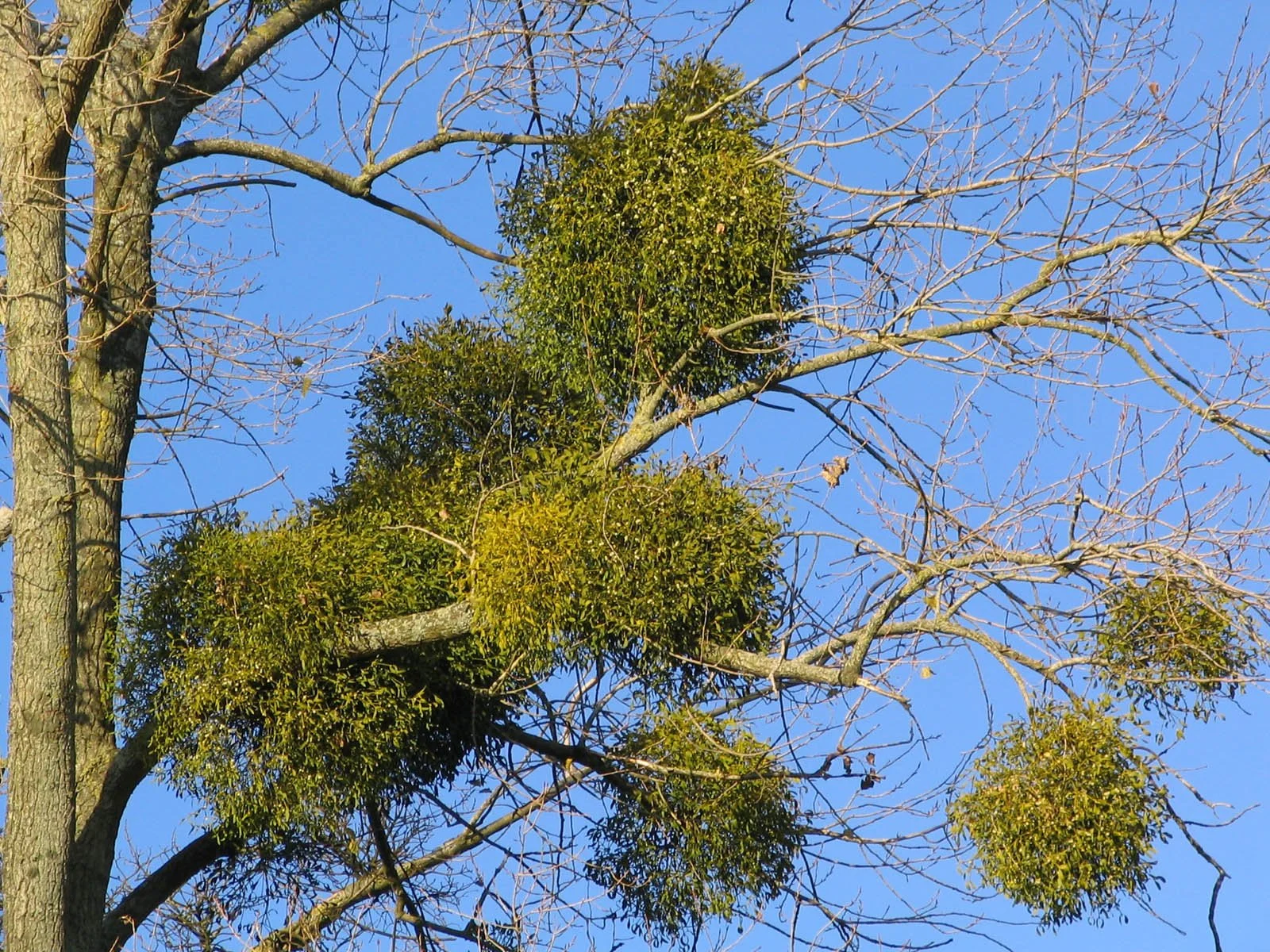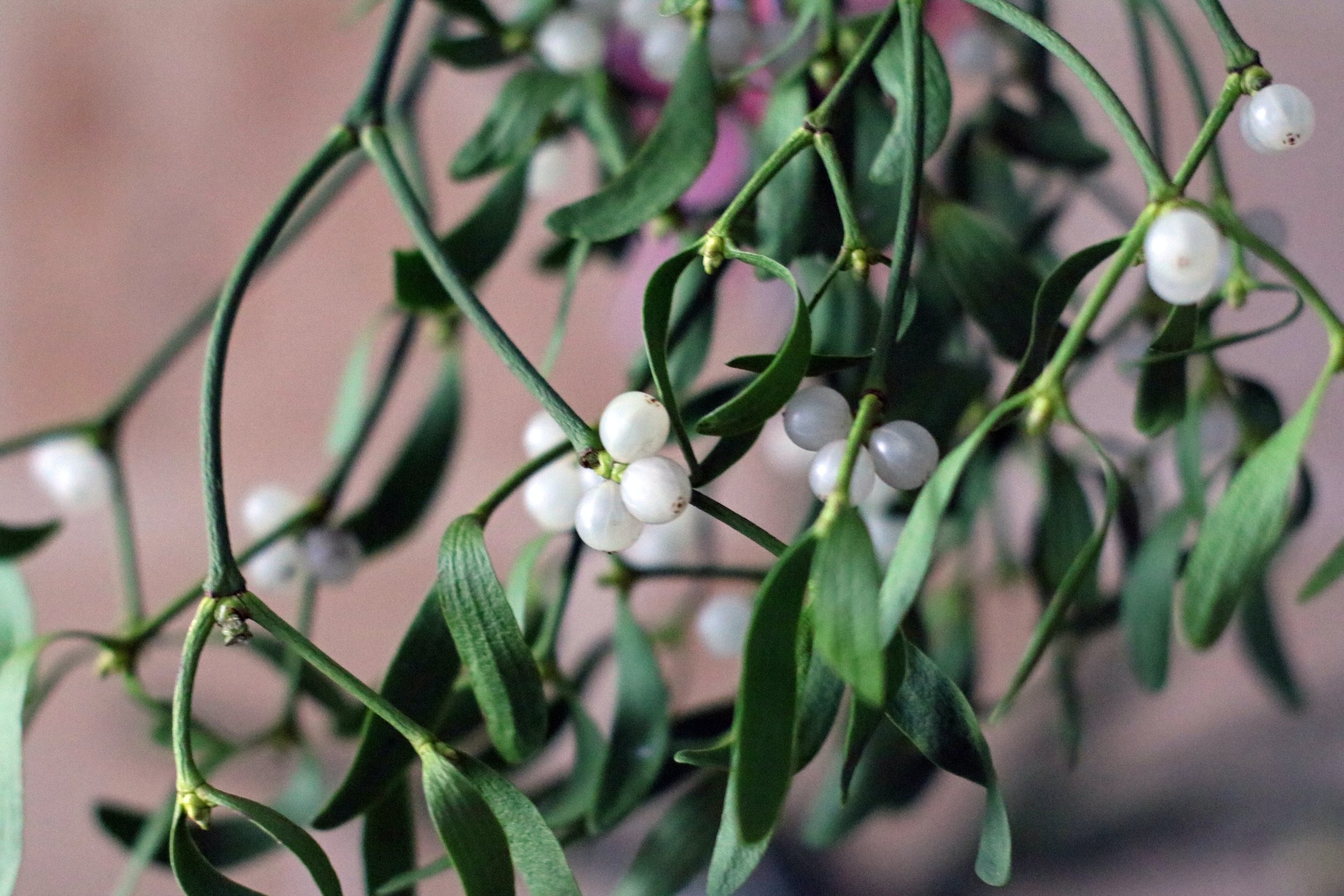We bought a sprig of mistletoe from a fundraising boy scout this holiday season and hung it in the kitchen doorway. This morning, wiped out from Christmas cooking and socializing, I was staring at it wondering how in the heck did this parasitic plant turn into a kissing apparatus?
First off, you probably know that mistletoe is a parasite. There are several varieties, the most common being the European, which likes to feast on apple trees, poplars, willows, lindens, and hawthorns. In the U.S., we mostly see the Eastern or oak mistletoe (Phoradendron serotinum), which parasitizes many deciduous trees, including oaks. (By the way, I didn’t know “parasitizes” was a verb and I’m very excited about that!)
So basically, this romanticized plant is considered a pest by most arborists.
Oak-oak-tree-mistletoe-plants-Eastern (Britannica.com)
If you’ve looked up into the branches of an oak tree and seen a big cluster of mistletoe that resembles a wind-tangled rat’s nest of hair, you’re looking at what’s called a “witches’ broom.” Perhaps mistletoe would be better symbolic of a different and more sinister holiday. Witches’ brooms deform branches and decrease the reproductive ability of the host. While that mistletoe may be sexy for us, it’s a total buzzkill for the trees.
Mistletoes are slow-growing but persistent and the only way they die is if the host tree dies. The only other solution is the complete removal of the parasite from the host. So, that fundraising boy scout was actually helping his environment while selling a parasite for $5 a baggie.
It gets even better!
Those pretty white berries you see in your friendly mistletoe, when ripe they are filled with a sticky semitransparent pulp that contains toxic compounds poisonous to many animals and to humans.
However, we as humans have a long tradition of taking controlled amounts of poisons for medicine or pleasure (like alcohol). The Ancient Greeks used mistletoe as a cure for everything from menstrual cramps to spleen disorders. The Roman naturalist Pliny the Elder (Great name! Do you think the other kids called him Pliny the whiney on the playground?), he noted it could be used as a balm against epilepsy, ulcers and poisons. Poison against poison. Cool.
However, it appears that the kiss under the mistletoe has fuzzy origins with the Druids around the first century B.C. Love those Druids! They saw green leaves and berries blooming in the frozen winter on otherwise barren trees and said, “Holy moly, that stuff is magic!”
So, they fed this sacred symbol of vivacity to humans and animals alike in hope of restoring fertility. There are no records of the results of this ancient Viagra. And it certainly wasn’t administered with the surgeon general’s warning.
But, nonetheless, this myth (or belief) persisted. In Norse mythology, when the god Odin’s son Baldur—god of peace and love—was prophesied to die, his mother Frigga (or Frigg), the goddess of motherhood, fertility and LOVE—now we’re getting somewhere!—was beside herself worried and spoke to all the animals and plants on the earth making them promise that they would not harm her precious baby boy.
“Okay, okay, geez,” they all said, “you have our word. Don’t be a helicopter mom!”
Frigg was overjoyed. Her son would be safe after all. But it was a prophesy, and you know how pesky and persistent those are in stories. Frigga overlooked one very unassuming little plant. You guessed it. Mistletoe. I guess it just didn’t make it onto her spreadsheet.
The scheming god Loki saw this as a golden opportunity. He made an arrow from mistletoe and let it fly at the otherwise invincible Baldur and killed him.
I’m not sure I’ve seen the mistletoe plotline in a Marvel movie, but it would make a great Christmas special! Could work on Valentine’s Day too.
This story was passed down and, I don’t know, maybe it scared a whole bunch of Viking kids way too much. A sunnier version of the myth emerged in which the gods were able to resurrect Baldur from the dead. His mother was so thrilled she declared mistletoe a symbol of love and vowed to plant a kiss on anyone who passed beneath it.
People like a happy ending.
Photo by Clement BB on Unsplash
In yet another rendition, Baldur died and Frigga's tears of grief fell onto the mistletoe and that’s what formed the white berries. She declared that forever after everyone would have to make peace and have a kiss when under the mistletoe, even if it is with your enemies. I like the peace-making element of that.
Into the Middle Ages, mistletoe was still associated with fertility and vitality.
Rene Rousseau as Frigga in the Marvel Thor and Endgame movies
How it ended up being incorporated into Christmas celebrations by the 18th century is a hotly debated parasitic mystery. But according to History.com, the kissing tradition first caught on among servants. Then it spread into the middle classes. At that time the custom was that men were allowed to “steal a kiss” from any woman standing under the mistletoe, and if she refused, it was bad luck. #MeToo! I think mistletoe should be for consensual kisses only, thank you very much.
Besides kisses, it turns out that European mistletoe is still used as a medicine. It is one of the most widely studied complementary and alternative medicine therapies for people with cancer. In Europe, mistletoe extracts are among the most prescribed drugs for cancer patients, and few side effects are reported. Austrian philosopher Rudolph Steiner first recommended mistletoe extract as a potential cancer treatment in 1920. Dutch physician Ita Wegman was the first to use it in a person with cancer shortly after.
You can even purchase mistletoe extract on Amazon!
It is not approved by the U.S. FDA, but we’ll see what future research reveals. I hate to say it, but we may only see it approved in the U.S. if it also has a good pharmaceutical profit margin. Pessimistic or realistic?
On the other hand, who knows, maybe those Druids knew what they were doing after all! A kiss with a loved one might be just one of the health benefits of mistletoe, parasite or not.
Kiss kiss! And happy new year!
Photo by Jakob Owens on Unsplash





